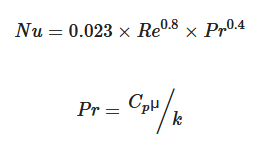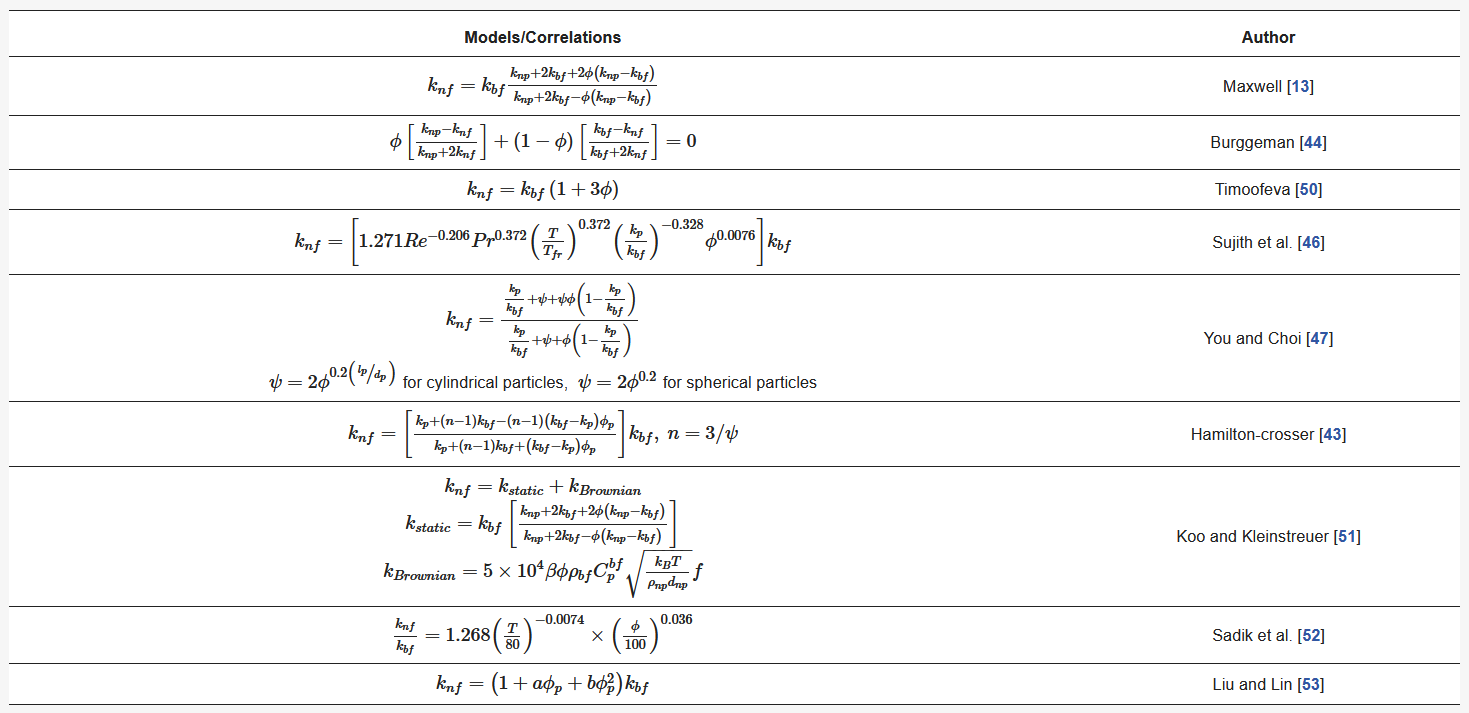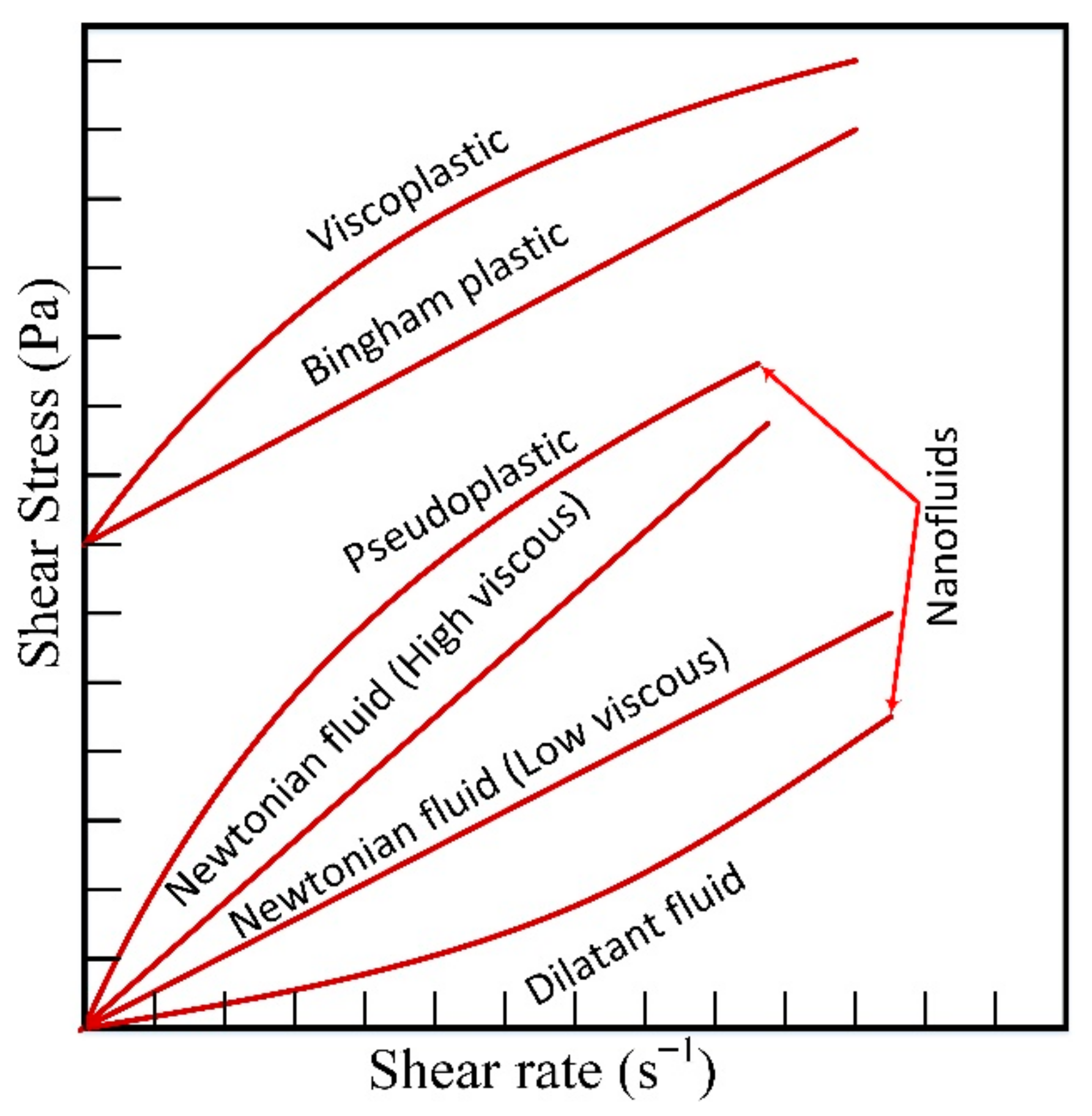Energy consumption in the industrial sector can be significantly reduced by improving heat transfer rates in heat exchanger circuits, pool boiling, metal cutting industries, etc. Numerous energy-related issues can be overcome to a large extent by improving heat flow properties by utilizing nanofluids. As to the improvement in thermophysical properties of metal oxide-based nanofluids, key parameters affecting the thermophysical properties of nanofluids, such as particle volume fraction, temperature, particle size and various stabilizers, were involved. The importance of DLVO theory and zeta potential to control the electrostatic repulsion and pH values of nanofluids for stable nanofluid formulations were highlighted. It has been observed that classical theories of thermal conductivity and viscosity cannot predict exact values for a wide range of variables. Therefore, various extensive correlations have been introduced to predict the thermophysical properties of nanofluids.
- thermal conductivity
- zetapotential
- viscosity
- specific heat
- wettability
- pool boiling
- energy efficiency
1. Introduction
2. Effect of Metal-Oxide Based Nanofluids on Thermophysical Properties
2.1. Specific Heat
Specific heat capacity (SHC) of a nanofluid is defined as the capability of the nanofluid to absorb heat energy without any phase change. It quantifies various essential thermal behaviors such as the rate of heat transfer, the efficiency of the heat exchanger and the average Nusselt number. Specific heat capacity is critical to the accurate design and assembly of heat transfer applications through cooling and lubrication systems, such as solar collectors, refrigeration and air conditioning, machining, etc. [16][17][18]. The governing equations below show the effect of specific heat capacity on thermal transport properties such as thermal diffusivity, thermal conductivity, density, and the efficiency of the heat exchanger, etc.2.1. Specific Heat




| 1.67 |
| Fedele et al. | |||||
| [ | |||||
| 39] | Fedele et al. [61] | TiO2 | Bidistilled water | 10–70 | 2.8 |
| Sujith et al. [9] | Al2O3 | Coconut oil | 30–140 | 2.5 | |
| Georgiana et al. [40] | Georgiana et al. [62] | Al2O3/SiO2 | Distilled water | Ambient | 2.7 |
| Suhaib et al. [41] | Suhaib et al. [63] | ZnO | Paraffin oil | 25–55 | 1.62 |
| Yan et al. [42] | Yan et al. [64] | TiO2/MWCNT | Ethylene glycol | 25–55 | 1.94 |
| Kole et al. [43] | Kole et al. [65] | CuO | Gearoil | 10–80 | 2.8 |
| Andac et al. [44] | Andac et al. [66] | ZrO2 | Water | 10–70 | 1.8 |
| Sonawane [45] | Sonawane [67] | Fe3O4 |
| Models/Correlations | Author |
|---|---|
| Pak and Cho [19] | |
|
A, B and C are correlation coefficients |
Vajjha and Das [20] |
| Zhou et al. [21] | |
| Shekar and Sharma [22] | |
| Donghyun and Debjyoti [23] |
2.2. Thermal Conductivity

2.2. Thermal Conductivity
Over the years, several studies have been conducted on the thermal conductivity of nanofluids, and various theoretical and numerical models have been proposed. Classical models based on mixture and compound theory include those of Maxwell [13], Hamilton crosser [43], Bruggemen [44], Yamada, and Ota [45]. For example, Sujith et al. [46] experimentally investigated the thermal conductivity of pure coconut oil-based Al2O3 nanofluids, and the results obtained from Maxwell’s and Yamada’s models differed from experimental data by 22 and 28%, respectively. This is because these models considered only the conventional factors such as particle type, volume fraction, and base fluid type. Researchers also found many other simultaneous factors affecting the thermal conductivity of the nanosuspensions. Therefore, new mathematical models and empirical correlations were proposed by considering Brownian motion of the nanoparticles, nano-layering of the base fluid at liquid/nanoparticle interface, temperature of the base fluid, diameter of the nanoparticles and nanoparticle clustering [47].| Models/Correlations | Author |
|---|---|
| Maxwell [13] | |
| Burggeman [25] | |
| Timoofeva [29] | |
| Sujith et al. [27] | |
|
|
You and Choi [28] |
| Hamilton-crosser [24] | |
|
|
Koo and Kleinstreuer [30] |
| Sadik et al. [31] | |
| Liu and Lin [32] |
2.3. Viscosity
The study of a fluid’s response to the applied shear stress is called rheology [54]. Shear stress versus shear rate gives the rheological behavior of a particular fluid. The ratio of shear stress and strain rate is termed as viscosity, and this determines the rheological properties of a fluid. In general, fluids are categorized into Newtonian and non-Newtonian types. Newtonian fluids exhibit a linear relation between the shear rate and shear stress. While non-Newtonian fluids show a nonlinear relationship, and the fluid flow curve does not intersect the center of the axes of the coordinate system [33].
2.3. Viscosity

| Author | Nanoparticles | Base Fluid | Temperature-Range (°C) | Relative Viscosity (Maximum) |
|---|
 Encyclopedia
Encyclopedia


